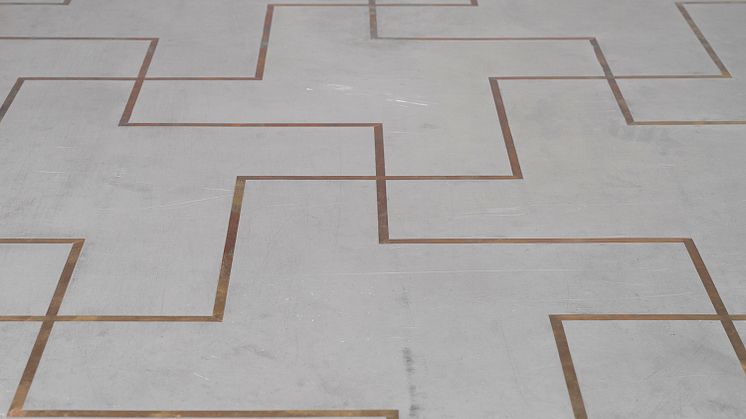
Press release -
Nationalmuseum acquires furniture by Uno Åhrén
Nationalmuseum has recently acquired a table and a tall floor screen from a pewter furniture set designed by the architect Uno Åhrén. These exclusive, custom-made furnishings embody tradition and a vision of the future at the same time. The pieces are the largest and most spectacular ever produced by Svenskt Tenn and can now be seen in the Scandinavian Design & USA exhibition opening on 14 October.
In the summer of 1928, the Swedish architect and designer Uno Åhrén (1897–1977) was commissioned to design a set of dining room furniture for Mrs Isabelle Mann Clow of Lake Forest, Illinois, in the Chicago suburbs. That year, she had visited Europe to buy furnishings for her exclusive new home designed by the architect David Adler in a classicizing style. Her shopping list included a glass dining table from Lalique in Paris, but after visiting Svenskt Tenn in Stockholm she changed her mind. She instead commissioned Uno Åhrén to design a large table for 18 people, and a tall floor screen (3.3 metres high) for the dining room. All the pieces were to be in mahogany, clad in matt pewter with patterned inlays of shiny brass.
Swedish architecture and applied art attracted international attention as a result of the 1925 Paris Exhibition (Exposition internationale des Arts décoratifs et industriels modernes). It is possible that Mrs Mann Clow visited the exhibition. Photographs of her home in Lake Forest show armchairs designed by Uno Åhrén and manufactured by Mobila, of a type exhibited in the “ladies’ salon” of the exhibition’s Swedish pavilion (NMK 202/2011 in the Nationalmuseum collection). Swedish design may also have caught her attention if she visited the Swedish Contemporary Decorative Arts exhibition at the Art Institute of Chicago in the fall of 1927, which included pieces of furniture by Uno Åhrén.
The custom-made furniture is unique, but in its execution it exemplifies exceptionally well some of the general features of late-1920s Swedish design, which was characterised by both tradition and innovation. The design of the table and screen illustrates the fusion of classicism with a modern material and machine aesthetic. The pieces were produced using traditional materials and artisanal techniques but are progressive in form and decoration. The table and screen consist of simple, sleek shapes. A design critic of the time declared that the furniture was “purely Functionalist in style” and showed a “complete absence of anything not required to render it fit for purpose”. The tabletop decoration in pewter has a shiny brass inlay. The pattern resembles a meander, but instead of framing and emphasising the shape of the table in the traditional way, the pattern breaks up the expanse, lending the monumental table an air of dynamism. The same effect is achieved by the pattern of diagonal lines covering the rectangular surfaces of the large, heavy floor screen.
“Nationalmuseum is delighted to have had the opportunity to acquire the large table and floor screen,” said Helena Kåberg, a curator at Nationalmuseum. “This acquisition is an important addition to our collection, expanding our perspective on 1920s design. It’s also part of our wider efforts over recent years to document the 1920s design scene.”
Before the pieces were exported, they went on show at Nationalmuseum in the spring of 1929 as part of an exhibition of contemporary Swedish pewter. Now this furniture can be seen again in the Scandinavian Design & USA exhibition, which opens at Nationalmuseum on 14 October.
Nationalmuseum receives no state funds with which to acquire design, applied art and artwork; instead the collections are enriched through donations and gifts from private foundations and trusts. The acquisition has been made possible by a generous donation from the Friends of Nationalmuseum (Otto Andersson Fund, Max Dinkelspiel Fund, Brita and Nils Fredrik Tisell Bequest, HM King Gustav VI Adolf Fund, Marit and Herbert Bexelius Fund, Barbro and Henry Montgomery Bequest) and the Hirsch Bequest.
Inventory numbers
Uno Åhrén, Table and screen, 1928. Mahogany, clad in pewter inlaid with brass. Svenskt Tenn. NMK 48/2021 and NMK 49a-b/2021.
Media enquiries
Helena Kåberg, Curator, helena.kaberg@nationalmuseum.se, +46 8 5195 4373
Hanna Tottmar, Head of Press, press@nationalmuseum.se, +46 8 5195 4400
Categories
Nationalmuseum is Sweden’s museum of art and design. The collections include paintings, sculpture, drawings and graphic art from the 16th century up to the beginning of the 20th century and the collection of applied art and design up to the present day. The museum building was closed for renovation for five years and reopened in autumn 2018.

